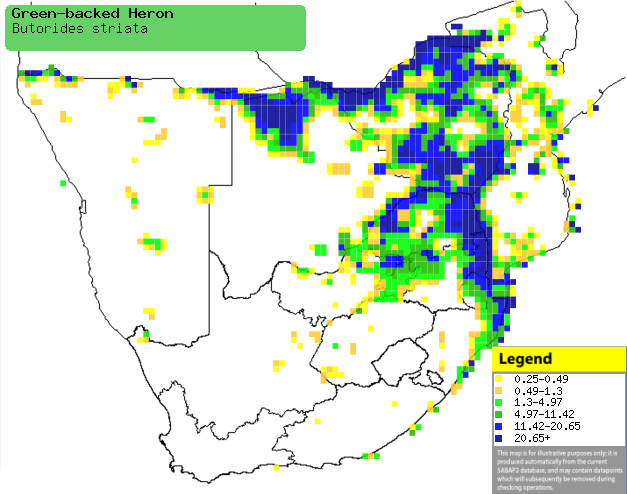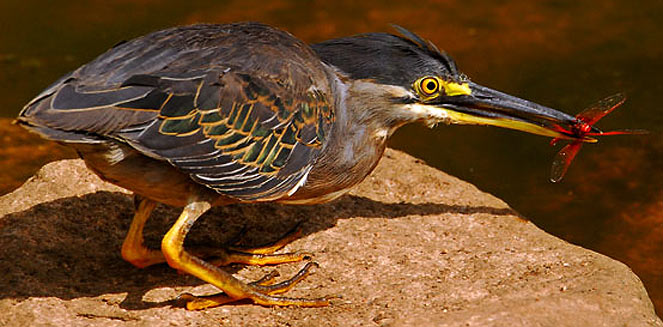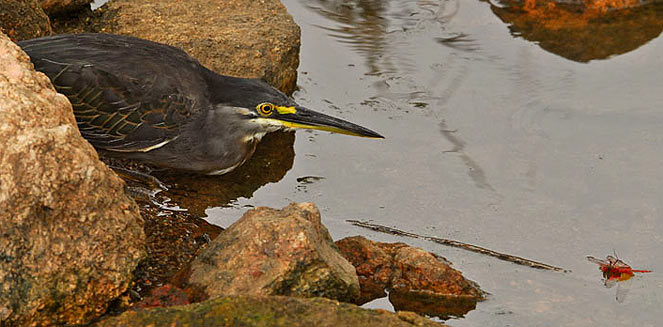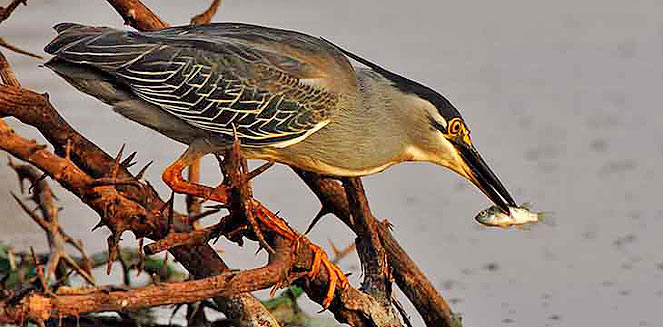|
Butorides striatus (Greenbacked
heron, Striated heron)
[= Butorides striatus]
Groenrugreier [Afrikaans]; Hakaruu (generic term for short-necked herons
and bitterns) [Kwangali]; Mangrovereiger striated, little, green-backed
[Dutch]; Héron strié [French]; Mangrovereiher [German];
Garça-de-dorso-verde [Portuguese]
Life
> Eukaryotes >
Opisthokonta
> Metazoa (animals) >
Bilateria >
Deuterostomia > Chordata >
Craniata > Vertebrata (vertebrates) > Gnathostomata (jawed
vertebrates) > Teleostomi (teleost fish) > Osteichthyes (bony fish) > Class:
Sarcopterygii (lobe-finned
fish) > Stegocephalia (terrestrial
vertebrates) > Tetrapoda
(four-legged vertebrates) > Reptiliomorpha > Amniota >
Reptilia (reptiles) >
Romeriida > Diapsida > Archosauromorpha > Archosauria >
Dinosauria
(dinosaurs) > Saurischia > Theropoda (bipedal predatory dinosaurs) >
Coelurosauria > Maniraptora > Aves
(birds) > Order: Ciconiiformes
> Family: Ardeidae
Distribution and habitat
Occurs across southern Asia, the Americas, Australia and
sub-Saharan Africa. In southern Africa, it
is uncommon to locally abundant in patches of Namibia (especially the Caprivi
Strip), northern and eastern Botswana, Zimbabwe, central and southern
Mozambique, Swaziland and north-eastern South Africa. It generally prefers
well-wooded shorelines of rivers, streams, lakes, ponds, mangroves, estuaries
and swamps, occasionally moving into more open areas such as mudflats, flooded
grassland and the seashore.
|
 |
|
Distribution of Green-backed heron in southern Africa,
based on statistical smoothing of the records from first SA Bird Atlas
Project (©
Animal Demography unit, University of
Cape Town; smoothing by Birgit Erni and Francesca Little). Colours range
from dark blue (most common) through to yellow (least common).
See here for the latest distribution
from the SABAP2. |
Movements and migrations
Generally sedentary, although it may move locally
in response to recent rainfall.
Food
It mainly eats fish and other aquatic animals, doing most
of its foraging by lurking in a crouched posture at the water's edge, grabbing
anything unfortunate enough to come within range. It may also use an insect,
spider, piece of bread or paper as a bait (as seen in the sequence of photos below),
snapping up any prey large enough to swallow. Perch-hunting has also been recorded, as it can uses its strong
eyesight to spot prey in the water, before diving in feet-first and sometimes
completely submerging itself. The following food items have been recorded
in its diet:
 |
|
Green-backed heron holding dragonfly. It catches
dragonflies not to eat, but to use as bait for fishing. [photo
Callie de Wet ©] |
 |
|
Green-backed heron, waiting for fish to take the
bait. If the dragonfly goes out of range, it positions it closer, so
that it can reach it with it's beak. [photo
Callie de Wet ©] |
 |
|
Green-backed heron holding fish. [photo
Callie de Wet ©] |
- Vertebrates
- fish
- Periophthalmus (mudskippers)
- frogs
- reptiles
- Invertebrates
- insects
-
spiders
- molluscs
- crustaceans
Breeding
- Monogamous and usually a solitary nester, although it occasionally breeds
in colonies of 5-15 nests in the same tree.
- The nest is a flimsy, saucer-shaped platform of sticks, twigs and reeds,
typically concealed on a branch of a tree or bush near water.
- Egg-laying season is year-round, generally peaking after rains.
- It lays 2-5 eggs, which are incubated by both sexes for about 21-27
days.
- The chicks are fed by both parents and brooded for the three weeks of
their lives, at which point they are able to fly weakly. They are capable of flying
strongly at 34-35 days old.
Threats
Not threatened.
References
-
Hockey PAR, Dean WRJ and Ryan PG 2005. Roberts
- Birds of southern Africa, VIIth ed. The Trustees of the John Voelcker
Bird Book Fund, Cape Town.
|
